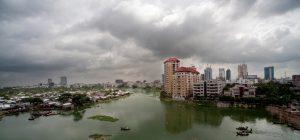The cities and towns of Bangladesh are being transformed—but at what cost?
In recent decades Bangladesh has experienced rapid urban transformation. The capital, Dhakar, has emerged as one of the world’s fastest growing mega-cities, and other cities and towns have experienced similar rapid growth during the period.
However, this transformation is resulting in widespread urban poverty and the increasing ‘peripheralisation’ of Bangladesh’s cities, brought about by the influx of people from rural areas, structural adjustment, corruption, a new consumer culture and increasing crime.
Millions of Bangladeshis are migrating to the cities because agriculture can no longer meet the economic needs of the growing rural population. Most of those arriving in the cities in search of work, however, are unable to find it because they lack the skills and training for jobs in the disappearing ‘formal’ economy and those needed in the rapidly growing technology-driven industries. Consequently, they are being forced out to the urban peripheries, where the manufacturing and garment industries with their poorly paid jobs are locating.
This massive rural migration is closely linked to growing urban poverty, as the poor in the cities and towns are mostly rural migrants. When asked why they moved to the city, most usually cite better prospects in the urban economy as the main reason. However, one could easily assume from the sight of the severe and widespread poverty in Dhaka, for example, that rural migrants do not really know what to do when they get to the city, and are unaware of the risk of being trapped in urban poverty.
Although the situation of the poor in cities like Dhaka has improved a little in terms of income and food consumption, many still lack access to shelter, infrastructure and social services. The stark inequality between the poor and the neo-rich, who are making fortunes through state–business nexuses and the corruption that has become a pervasive part of urban life, is becoming a key challenge in Bangladesh’s cities.
Economic restructuring
Economic restructuring is another major factor in the expanding urban peripheries. The inability of ‘formal’ labour markets to absorb the millions of people seeking work and the increasingly regulated ‘informal’ economy are generating a substantial increase in unemployment and underemployment. Those who depend on the informal economy for their livelihoods are being forced into degraded living conditions either in the cities themselves or on the peripheries.

Urban development and renewal, although necessary, are also adding to the problems of the poor and, as is the case with many other cities in other countries, are benefitting only a small portion of the urban population. Dhaka has been transformed rapidly, with its landscape now dominated by new developments and an array of real estate advertisements offering lucrative land and housing deals. The majority of these development projects, however, are at the high end of the real estate market, with the exception of a few housing projects where access has been determined on having connections to political parties. There have been only a limited number of public housing projects, but these, too, are often occupied by those connected to the parties in power.
Adding to the hardships for the poor is the privatisation of many urban services. With the state withdrawing from its social commitments, many services, particularly in education and health, are being provided by non-state agencies and the private sector. The cost of accessing them is beyond the reach of the poor. Education has become a commodity and only the rich can afford the growing number of private hospitals and clinics. Despite the prevalence of illness and disease in the slums, especially among infants and children, the poor have limited access to affordable healthcare services.
Land-grabbing on the peripheries is also breeding crime and violence, with fraud, kidnapping and murder now the most common crimes related to land in greater Dhaka
As industries are forced to the peripheries because of the ready availability of land and labour there, pollution is significantly increasing and affecting the natural environment. The use of industrial chemicals is not only damaging the environment but also creating dangerous health risks for the millions of people who are forced to live in these areas.
Increasing crime
Increasing crime and violence has been another consequence of Bangladesh’s rapid urbanisation. New technologies are providing opportunities for new forms of crime such as money-laundering, fraud and cybercrime. Land grabbing on the peripheries is also breeding crime and violence, with fraud, kidnapping and murder now the most common crimes related to land in greater Dhaka. Landowners are often tortured by powerful land grabbers and forced to leave their land.
Further displacement of the poor to the peripheries is also occurring as a result of the developing consumer and youth culture in the cities. As more and more land is privatised for new shopping malls, restaurants, cafes, beauty parlours and gymnasiums, the few benefit at the expense of the poor.
Such is the reality behind Bangladesh’s changing urban landscape. While urban renewal and development are bringing benefits and prosperity to the few, the plight of the urban poor—mostly rural migrants—is being exacerbated by the changes. Without the development of more ‘poor friendly’ and inclusive policies by government and access to basic urban services, the cities and towns of Bangladesh will become even more unviable for the increasing millions already struggling to exist there.
Featured image
View of Gulshan, one of the most important economic centers in Dhaka. Photo: Flickr

